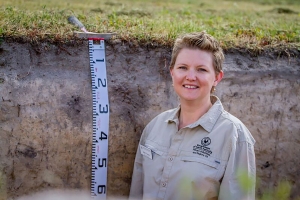Proactive approach needed as soil acidity issues spread
Proactive approach needed as soil acidity issues spread
Date: 09 Nov 2020

Soil acidity could be the cause of unexplained yield losses for grain growers, with researchers reporting a growing problem in South Australia.
Growers are therefore encouraged to soil test, especially given that much of SA’s 4.4 million hectares of productive farmland has a topsoil pH below 5.5 (measured in calcium chloride) or has the potential to become acidic in the near future.
SA Department of Primary Industries and Regions (PIRSA) soil consultant, Melissa Fraser, who features in a new GRDC ‘The lowdown on subsurface acidity’ podcast, says the natural soil acidification process is accelerated by productive modern farming practices, and the problem is occurring deeper in the soil.
-
GRDC PodcastPodcast
GRDC Podcast: The lowdown on subsurface acidity
In this podcast, Primary Industries and Regions SA soil consultant Melissa Fraser shares the latest subsurface acidity research findings and management advice.
Date: 16 Sep 2020
While most SA soils were neutral or alkaline when first cleared, decades of crop and pasture production have slowly reduced pH levels. Increased use of nitrogen fertiliser, greater removal of grain and stubble for hay, and the inclusion of legumes in a cropping rotation are all factors that have increased soil acidification under modern farming systems. Root growth and uptake of water and nutrients are reduced under acidic conditions, and low pH also causes toxic levels of aluminium which severely impair root growth.
“Typically, the topsoil becomes acidified first and if this is not addressed, the acidic layer spreads down the soil profile over time, retarding root penetration of acid-sensitive plants,” Dr Fraser said.
Spreading lime will remediate soils affected by acidity but lime takes many years to move into the subsurface. The movement of lime into the subsurface can be enhanced through incorporation or strategic tillage.
Pulse crops, such as lentil and faba bean, are more acid sensitive than wheat, so if pulse productivity starts declining, soil acidity could be the cause. Crop decline is often first noticed on the lighter textured soil types within a paddock where deterioration is evident early, especially in dry years. This can be easily picked up through NDVI images or yield maps.
By the time this decline is noticed, crop yields may have been restricted for many years and the acidity issue may be quite deep in the soil. So, a soil monitoring program is the best way of picking up emerging acidity early and avoiding the development of subsurface acidity.
“Traditional soil sampling of the 0-10 centimetres surface soil isn’t going to accurately identify any deeper acidity issues,” Dr Fraser said.
If subsurface acidity is suspected, Dr Fraser recommends growers and advisers sample in 0-5cm, 5-15cm and 15-25cm increments in good and poor zones across the paddock. In addition to pH and aluminium, she recommends getting a soil texture assessment and measuring organic carbon to understand the soil’s buffering capacity, which will assist with lime rate decisions.
According to Dr Fraser, the primary issue for many growers looking to address subsurface acidity is the fact that lime moves slowly down the profile in most soils, especially under no-till farming.
“Growers have done a great job of adopting no-till practices, which has helped improve soil health,” she said.
“However, strategic cultivation after topdressing lime really should be considered to mix the lime below the soil surface, thereby speeding up the remediating effect lime has on surface and subsurface acidity.”
Once acidity has been corrected throughout the soil profile, regular topdressings of lime without incorporation can ensure pH in the topsoil is maintained above 5.5 and subsurface acidity should not reoccur.
To understand more about lime movement in soils, liming rates and lime incorporation methods, visit the Acid Soils SA website.
This website and its resources form part of a GRDC investment which aims to improve grower and adviser understanding of the development of topsoil and subsoil acidity, limitations to crop profitability and improved management practices.
Project partners include PIRSA, the SA Department of Primary Industries and Regions, the SA Department for Environment and Water, the University of Adelaide, Trengove Consulting, Penrice and AgCommunicators.
Contact details
For interviews
PIRSA Communications
PIRSA.Media@sa.gov.au
Contact
GRDC Adelaide office Communications Manager – South
(08) 8198 8400
media@grdc.com.au
GRDC Project Code: UOA1905-015RTX,


